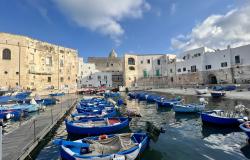Remote and hidden away, a couple of hours from Rome yet worlds apart, the solid heart of Italy beats with its own timeless rhythm.
Nestled within its wild and rough-hewn beauty, the city of Sulmona lies in the emerald basin of the Peligna valley within a vast and natural amphitheatre. Bold, flat-topped mountains brood over the landscape like silent giants. Huge masses of dark cloud often obscure their tops, from which snow plunges down the dark ravines in myriad slivers, while lower down swirls of mist hover above the forest-clad slopes.
It’s easy to understand why the Peligna valley has always been a place of contemplative hermitage. Sacred to the Goddess Maja by the ancient Paeligni, Petrarch named the valley simply Domus Christi, or house of god, for its proliferation of retreats and abbeys. More than a hundred hermits chose to retreat here, including a man who was carried down by a fervent crowd and installed as Pope Celestine V. Here, sheer isolation and the hostility of nature have prompted a unique folklore tradition, loaded with both pagan superstition and religious belief.
Magic, mysticism, the sacred and the profane have merged and regenerate themselves each year in timeless rituals. During Holy Week, Sulmona and its magnificent backdrop become the setting for one of the most solemn yet spectacular rituals in Italy, whose final culmination lasts only 15 seconds but requires a year of preparation.
An Age-old Tradition
Although the true origins of this ritual are lost in the mists of pre-Christian time, amongst spring fertility rites, it can certainly be linked to medieval popular drama. Fragments of a passion play written in the 14th century have been preserved, concerning the role of the fourth soldier and other characters in the Passion of Christ.
It is unclear when performances of this passion play ceased but over time it appears that the actors were gradually replaced with the giant statues of the modern ‘play’. On the evening of Maundy Thursday and the Last Supper, throngs of locals wind through the narrow cobbled streets and alleys of Sulmona to visit the local churches; this tradition of ‘fare i sepolcri’ occurs in many Abruzzesi villages (as in much of the South of Italy - ed) . Even this ceremony manages to hold its own superstitions: it is considered bad luck to visit an even number of churches.
Inside each church, the statue of the Dead Christ is illuminated in a holy sepulchre by flickering candles in dramatic chiaroscuro. In an ancient peasant ritual of death and mourning, the faithful approach in hushed silence. On Good Friday, the city has been transformed. Traffic-free, it bustles with visitors from every corner of the Abruzzo to attend the Procession of the Dead Christ and the Madonna Addolorata (our Lady of Sorrows). At dusk, the door of the church of S.S.Trinità opens to the hauntingly sad notes of a funeral march by Alberto Valla. Its slow, marching rhythm (used in several films by neorealist director Vittorio De Sica) is a prompt for a solemn procession to leave the church and wind its way through the streets, hemmed in by silent crowds of people and following an itinerary which traces out the sign of the cross. It is led by one of the most ancient confraternities of the city, the Trinitari, wearing shiny crimson surplices and white bib vests. The emotion of the confrati is strong; slowly, their humming dies down, and the church empties under the tormented eyes of Our Lady. She watches over her Son’s corpse from the altar, and prepares to follow in this agonising wake.
A Mournful Procession
The funeral band is followed by mace bearers and fanali, or lampbearers, who line the mournful cortege. Its opening lines form a square which encloses the Tronco, a cross made of cork over three metres high and covered with red velvet which is entwined with the shoots of silver vines. Other fanali precede a choir of almost 100 voices, who sing a beautiful Miserere, or requiem, in tenor and bass, composed by Sulmonesi musicians Barcone and Scotti.
They underline the sad and plaintive notes with the struscio, a slow and swaying shuffle of their shoes along the ground, the footsteps of mourning and loss. The choir are preceded by a group of children who carry the brutal instruments of Christ’s torture and martyrdom on Calvary. And, in the centre of the procession, we see the most dramatic of all: the mutilated body of the Dead Christ, on a striking black and gold catafalque surrounded by 33 red carnations and followed by Our Lady, whose sorrow is symbolized by a blood-soaked dagger which pierces her heart. Upon arrival at Piazza Garibaldi, part of the jurisdiction of the Confraternity of the Madonna of Loreto, control of the procession passes briefly into their hands. Soon, the Lauretani hand the statues and the cross back to the Trinitari, who bring the procession to an end at their own church under flickering lamps.
Change of Mood
On Easter Sunday morning, the mood has changed to one of joyful expectation. Control of events now passes into the hands of the Lauretani, who wear a white tunic and a green mantle to symbolize the purity and renewal of nature. Since the early hours, crowds have been building in Piazza Garibaldi. On balconies and terraces, in windows with good views, on the flights of steps and on the medieval aqueduct: every available place is packed with the spectators of a huge open-air theatre.
The ceremony begins in earnest just before midday, as a procession of Lauretani eaves the church of Santa Maria della Tomba bearing the statues of the Risen Christ and the apostles Saint John and Saint Peter. The Risen Christ remains under the central arch of the aqueduct, while the two saints proceed to the church of San Filippo Neri where, the evening before, the mourning Madonna of Loreto (not the one in procession on Good Friday) has been carried. Slowly, the two saints approach the threshold of the church. Knocking on the door, Saint John announces to the Virgin the news of the Resurrection, imploring her to come out. But she steadfastly refuses to believe him. Nor does she believe Saint Peter, the apostle who denied Christ three times.
The Dashing Madonna
When Saint John tries a second time, the door finally opens and a black-clad Madonna moves forward slowly and hesitantly, clutching a white handkerchief. The excitement building in the crowd is palpable. As she moves forward to the fountain, she seems to be standing on her toes and peering into the distance. And then she is pervaded by a perfect bliss…. Suddenly she breaks into a frantic dash, with help from her sturdy bearers beneath. It is a moment of explosive joy, heralded by the deafening report of firecrackers.
As she runs towards her Son, the dark cloak falls away to reveal a bright green dress – the rebirth of hope – and a red rose in place of the white handkerchief. A flock of white doves is released into the air. The pace seems to accelerate, as the crowd roars in approval and the church bells toll merrily, until Mother and Son are joyously reunited. Superstition is never far away. If the run is good, the year will be good; if the cloak fails to fall off properly, it is a dark omen. Only when the doves fly high and free will the crops succeed. But this time the omens are excellent, and another year in the endless cycle of death and rebirth in this timeless place can begin once again.





